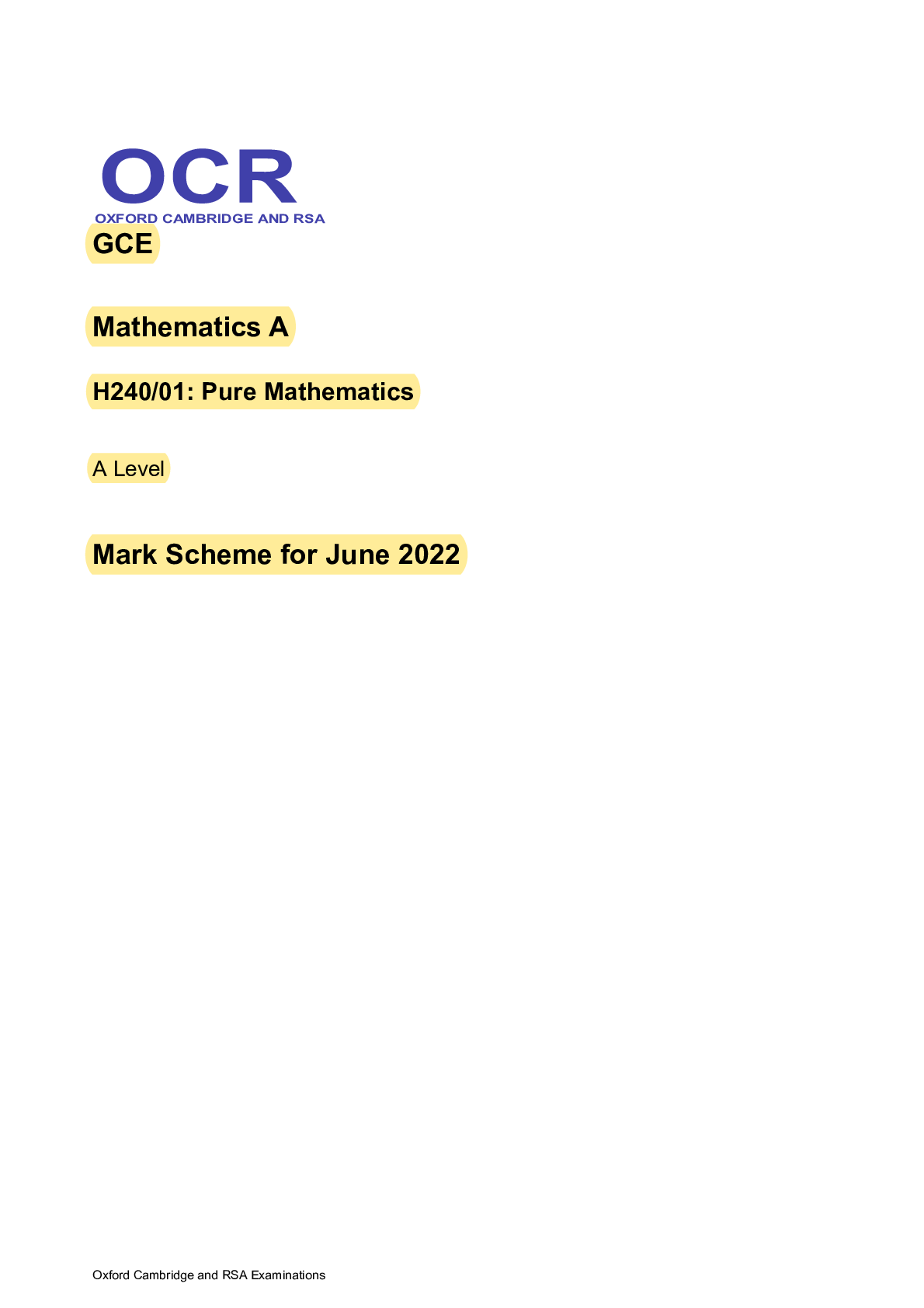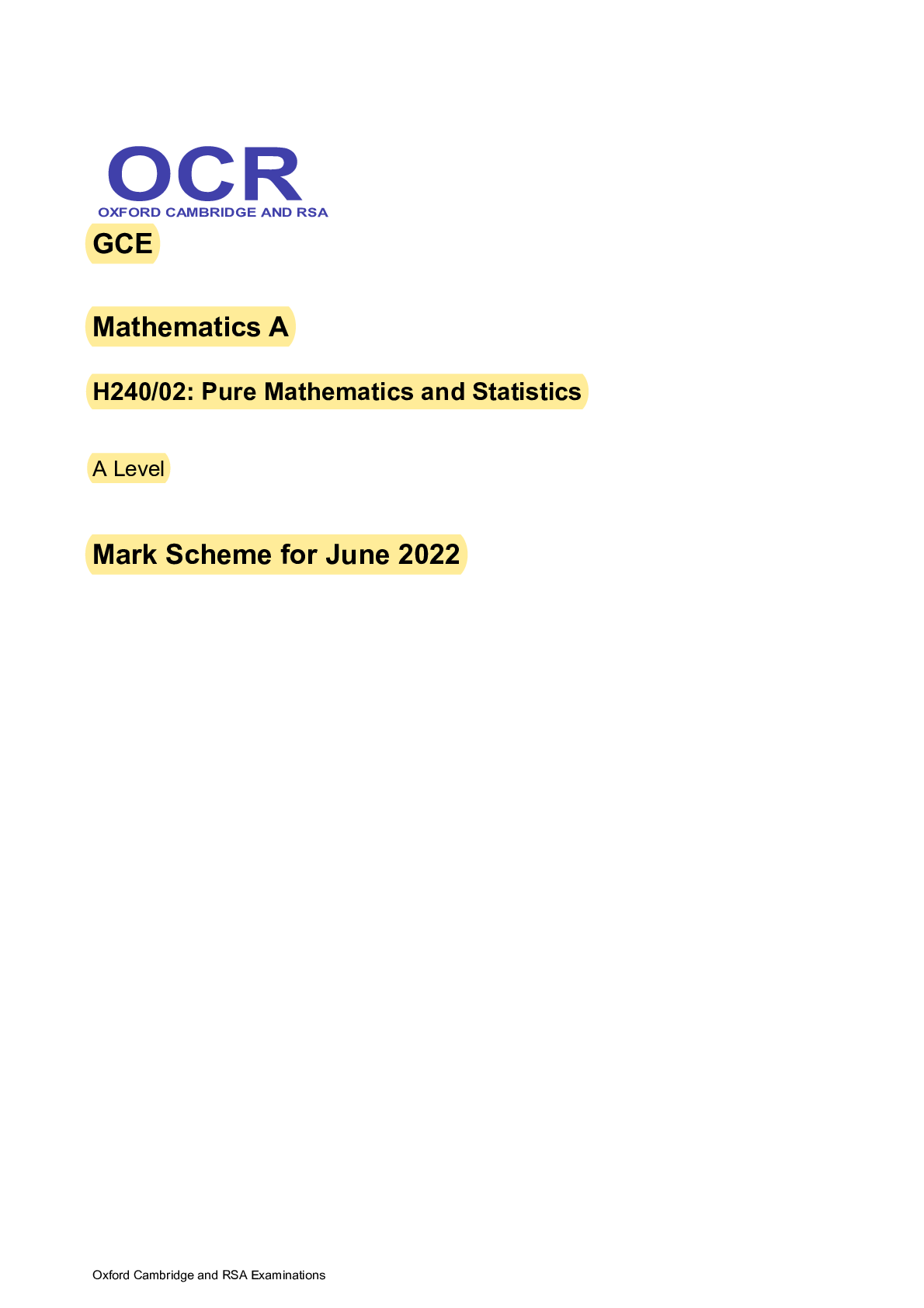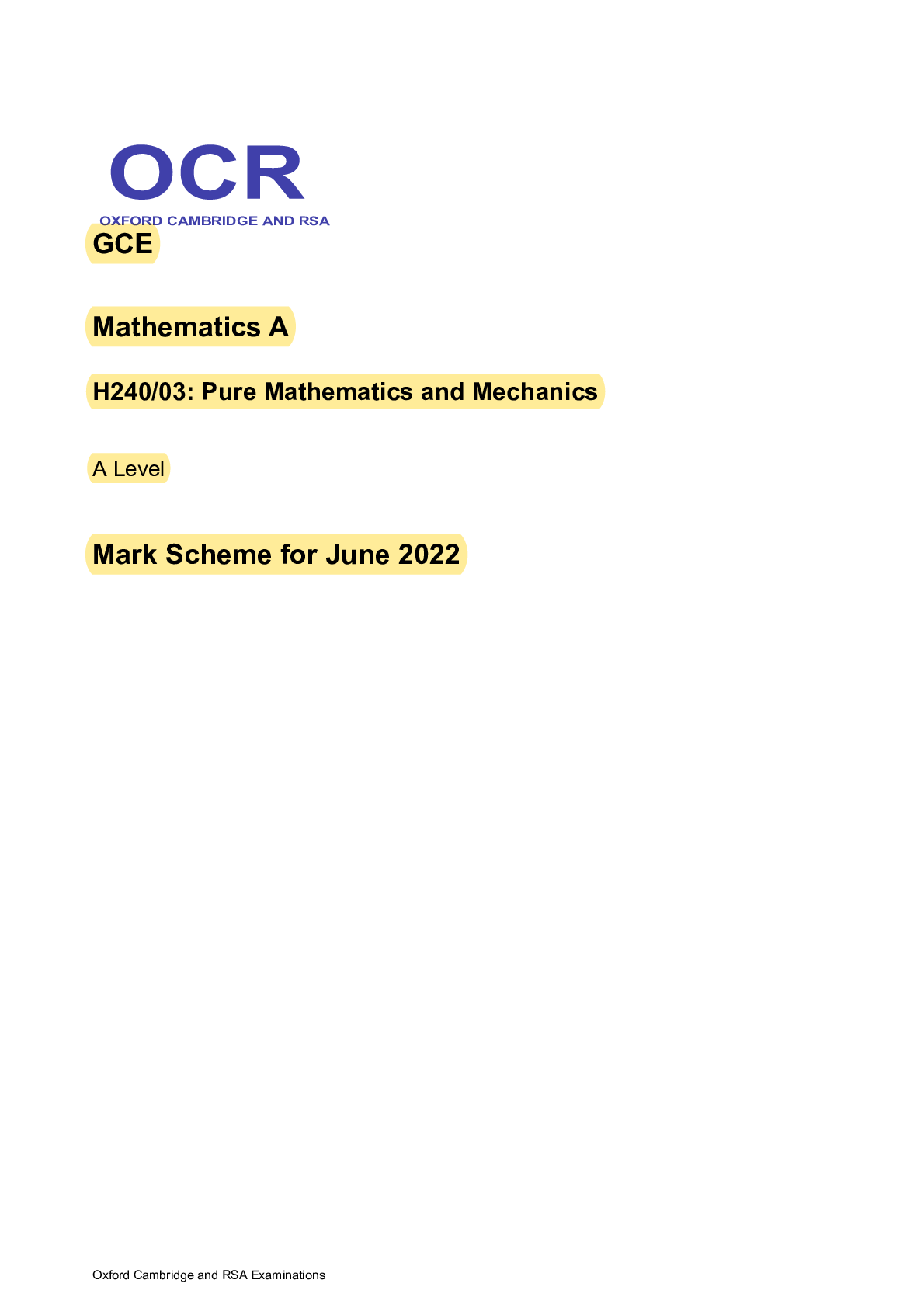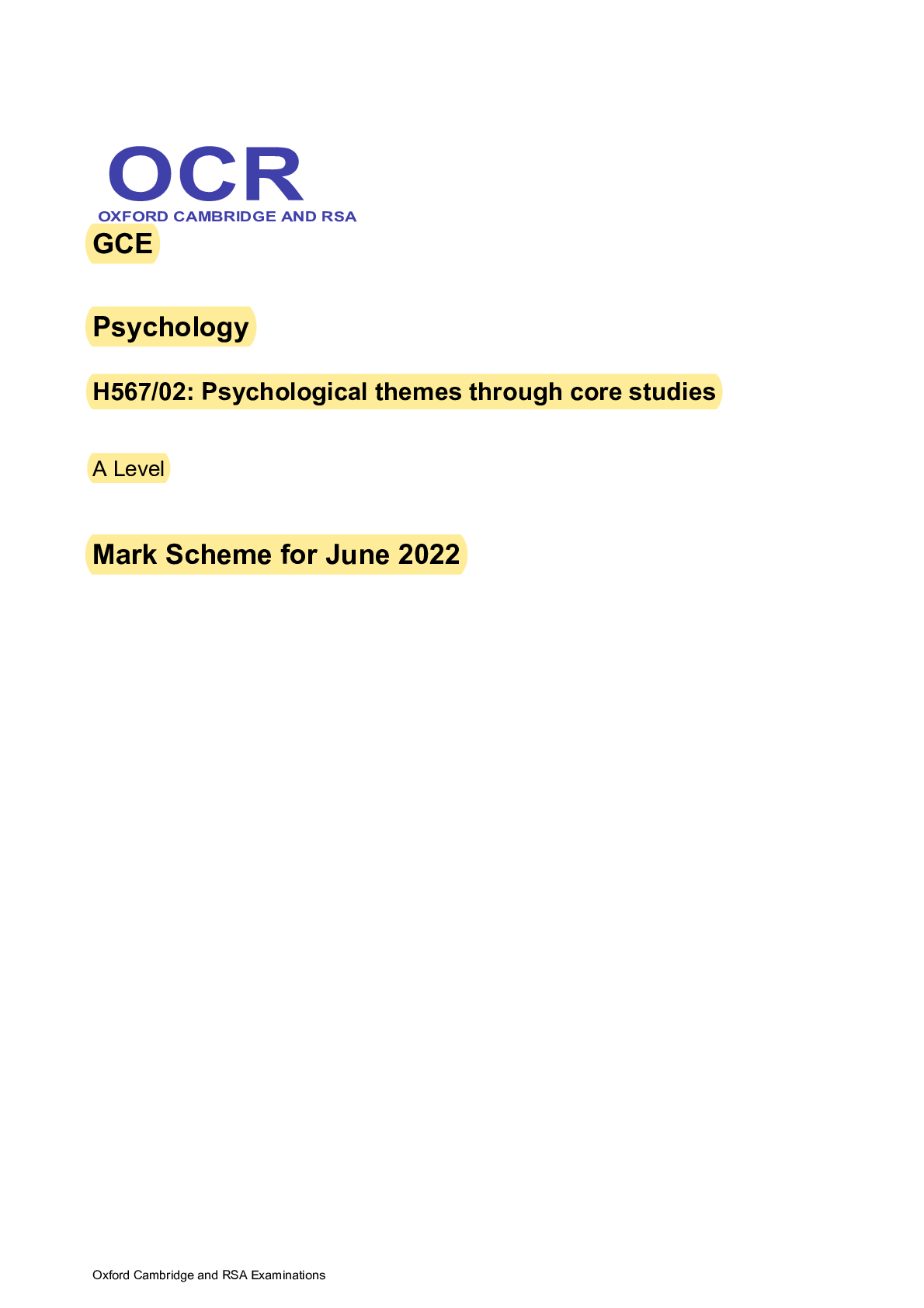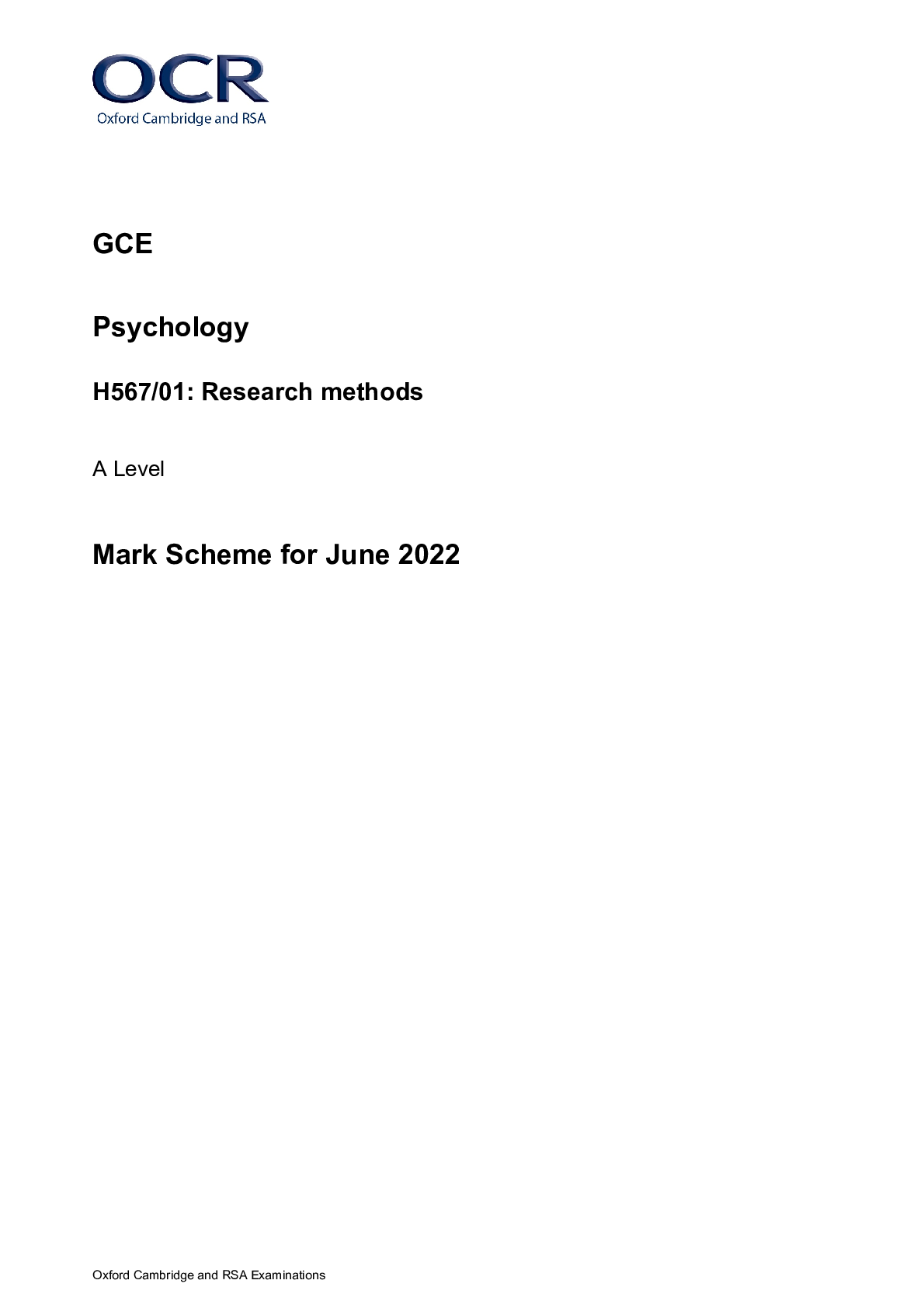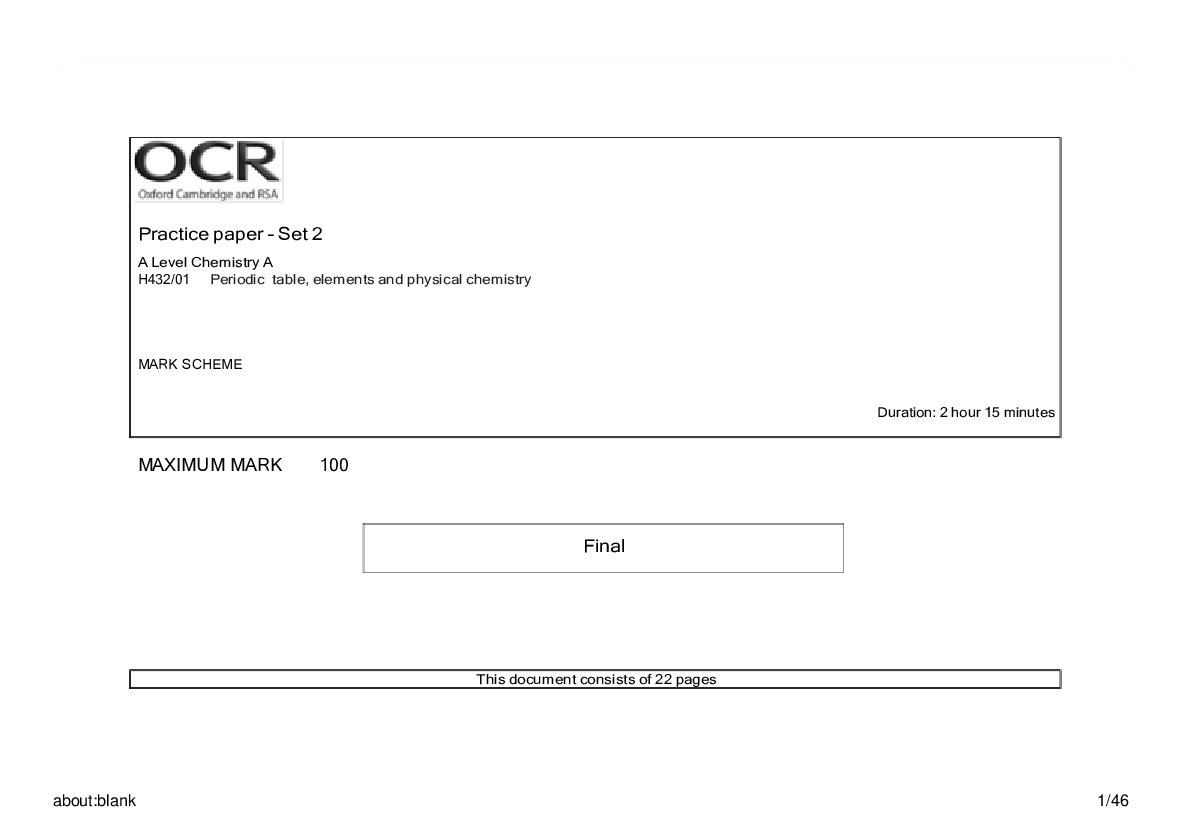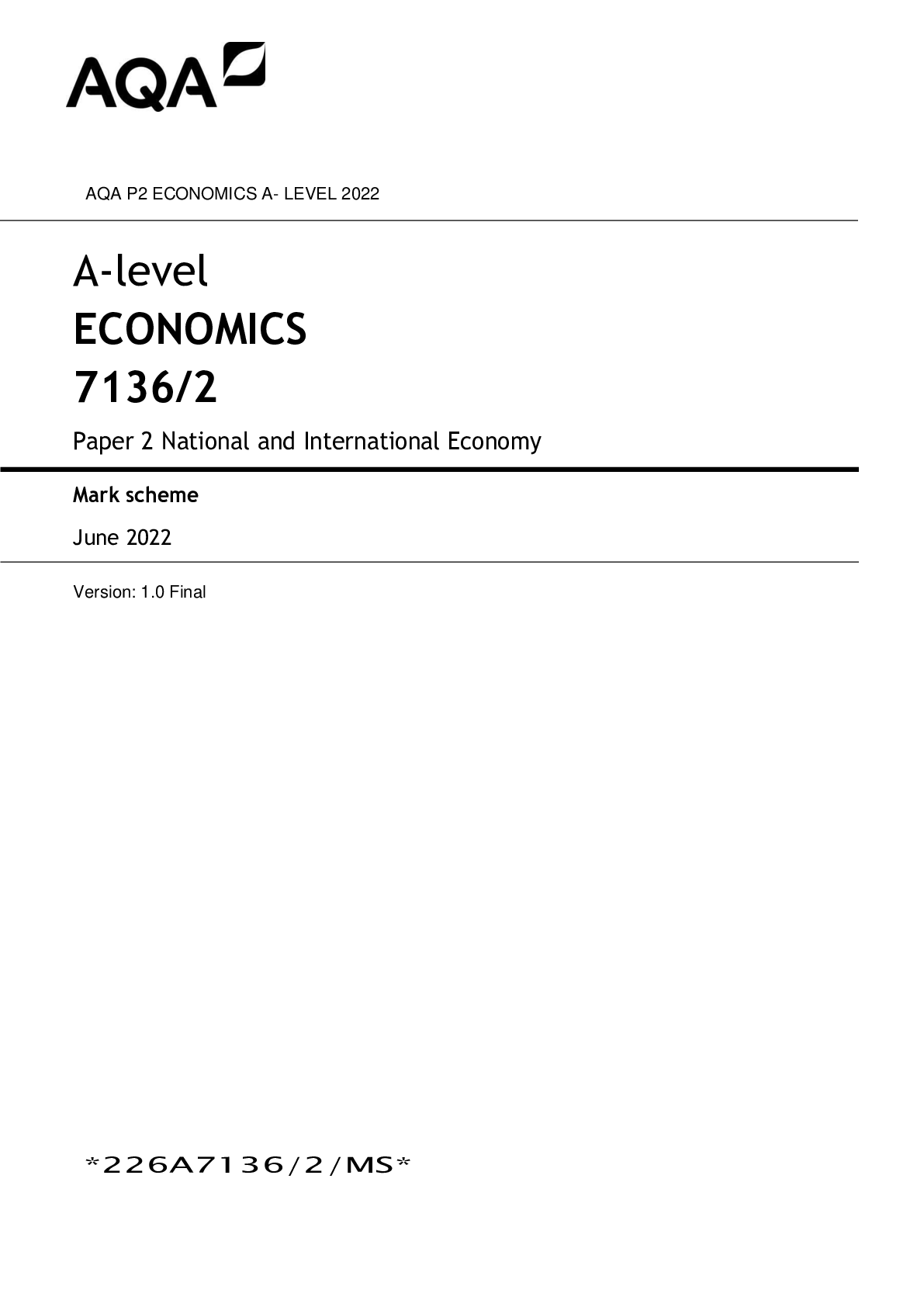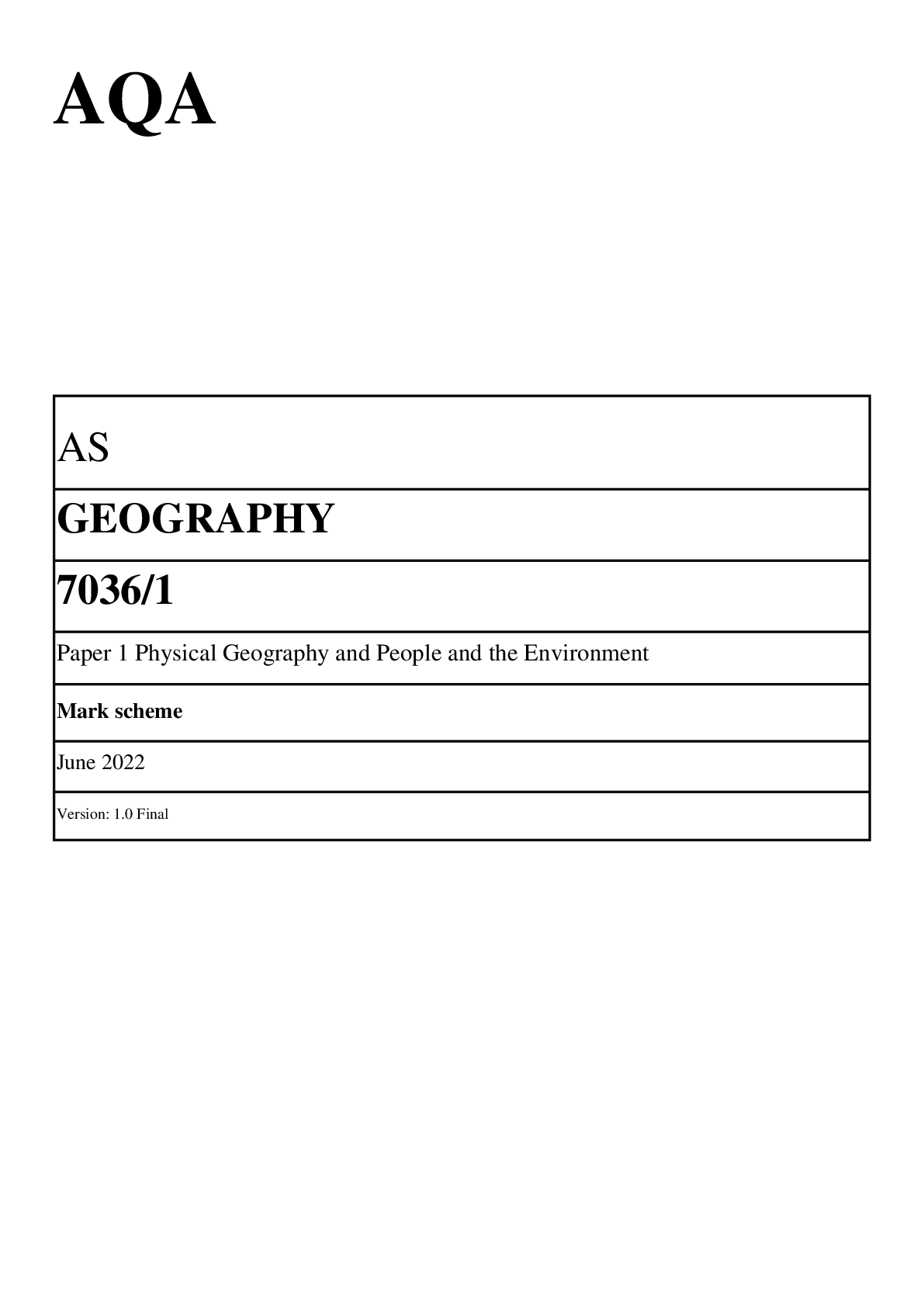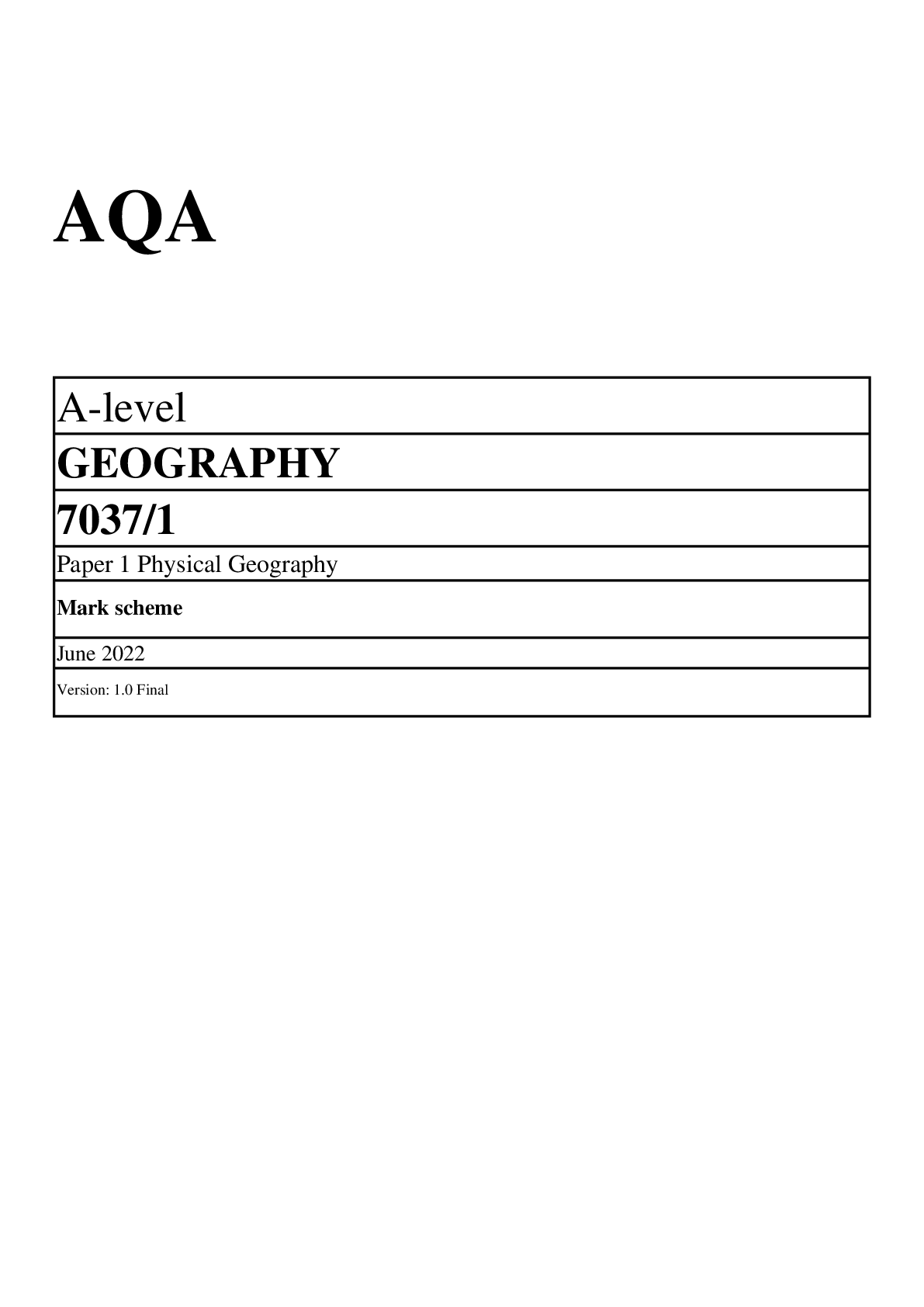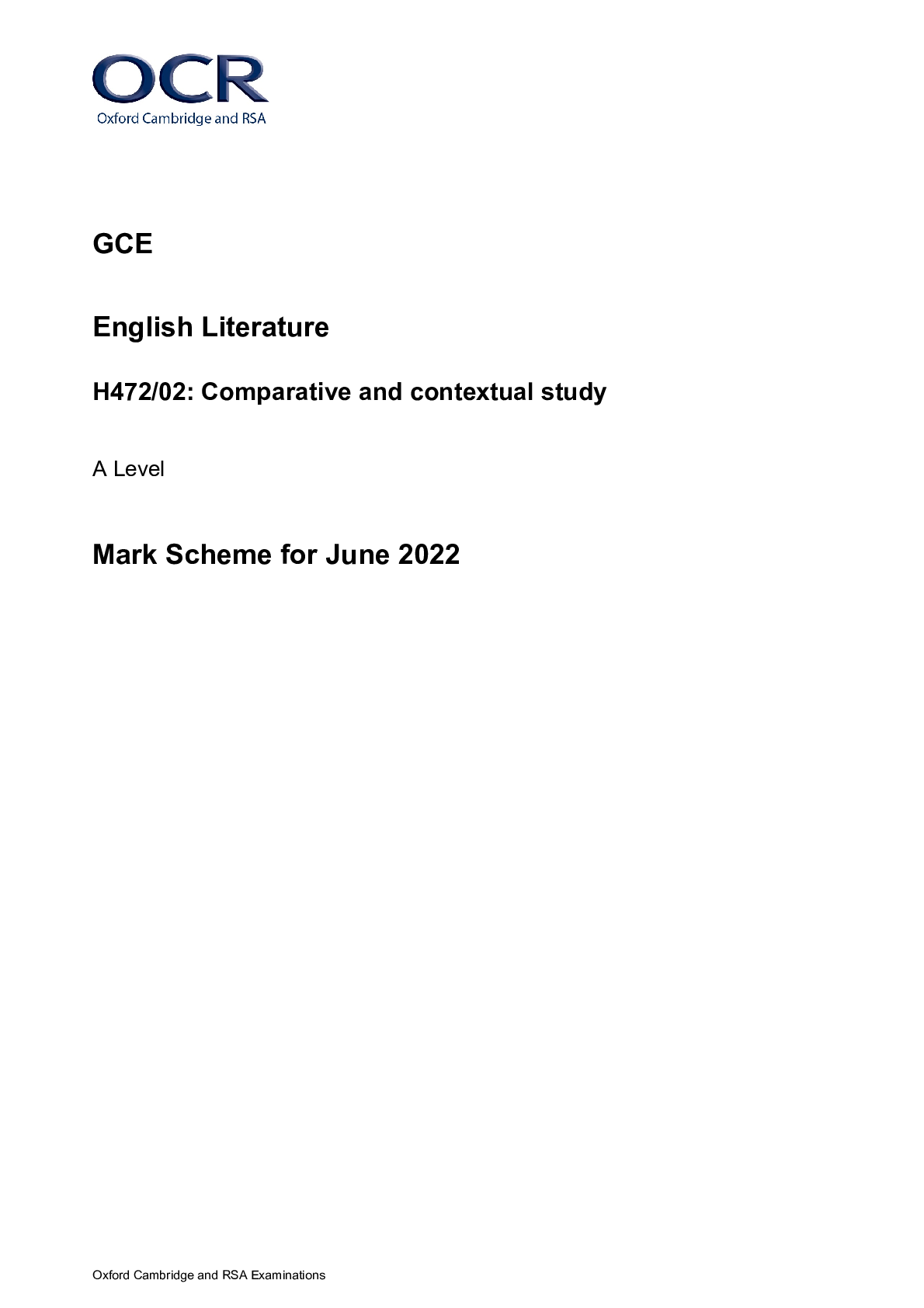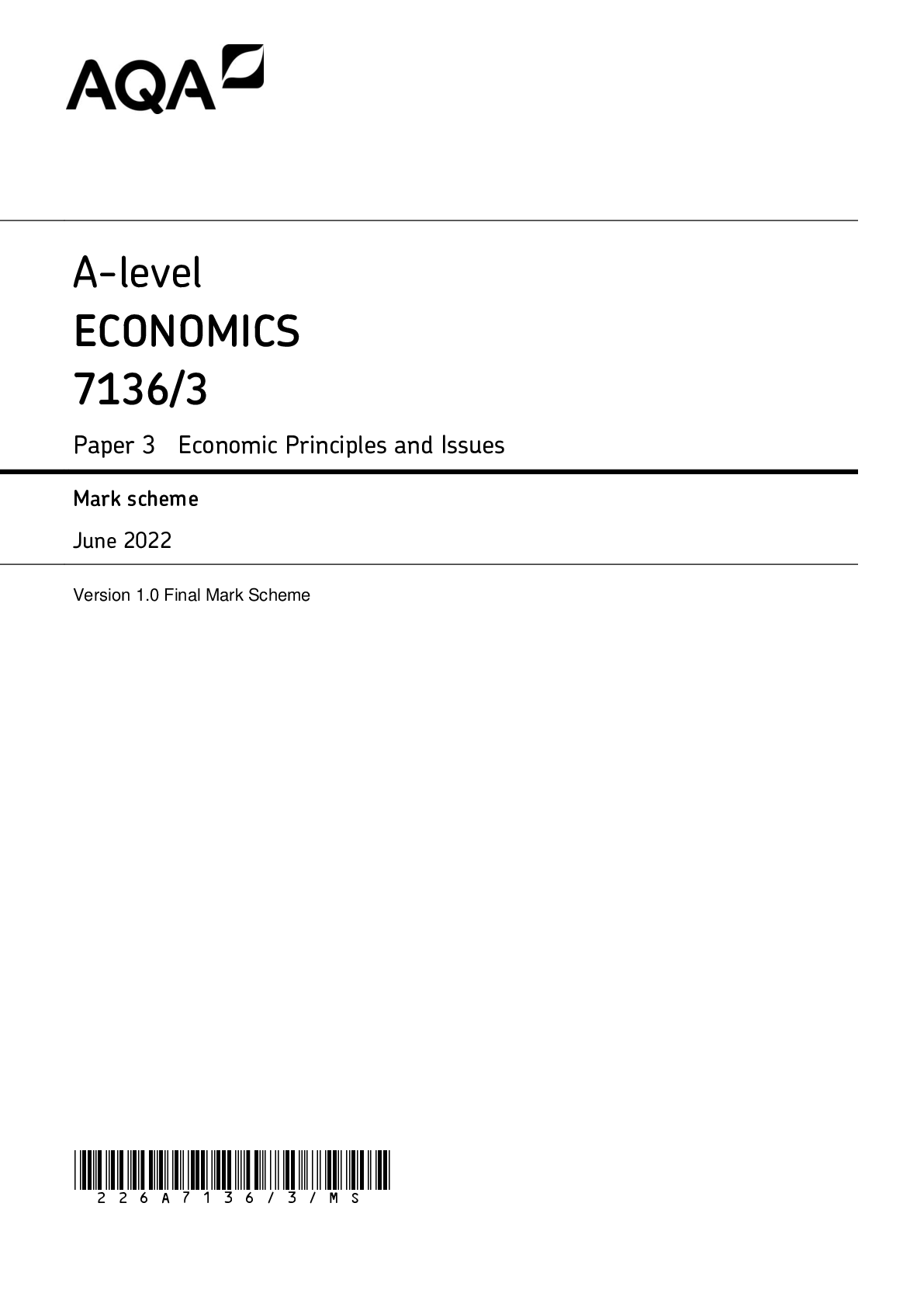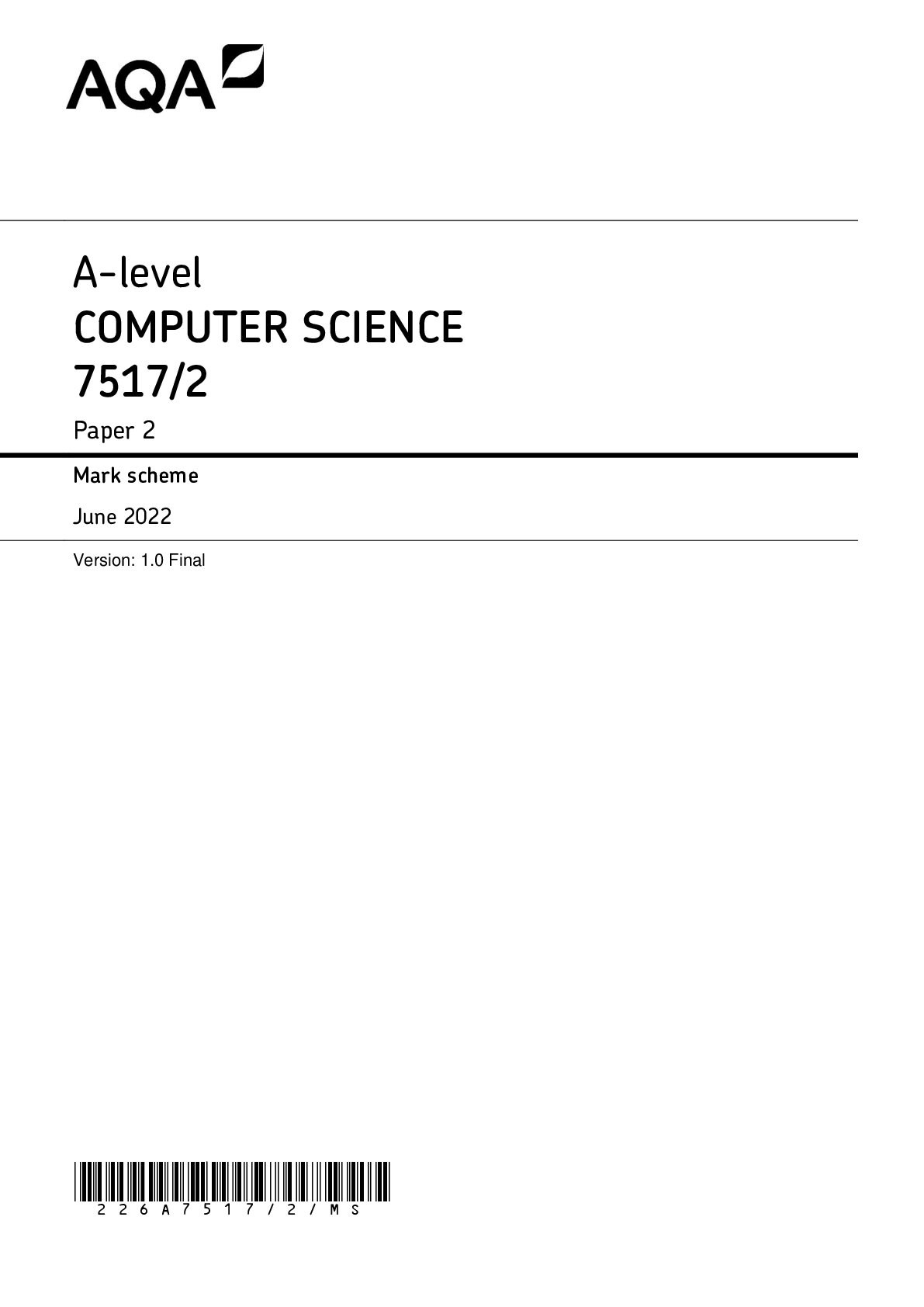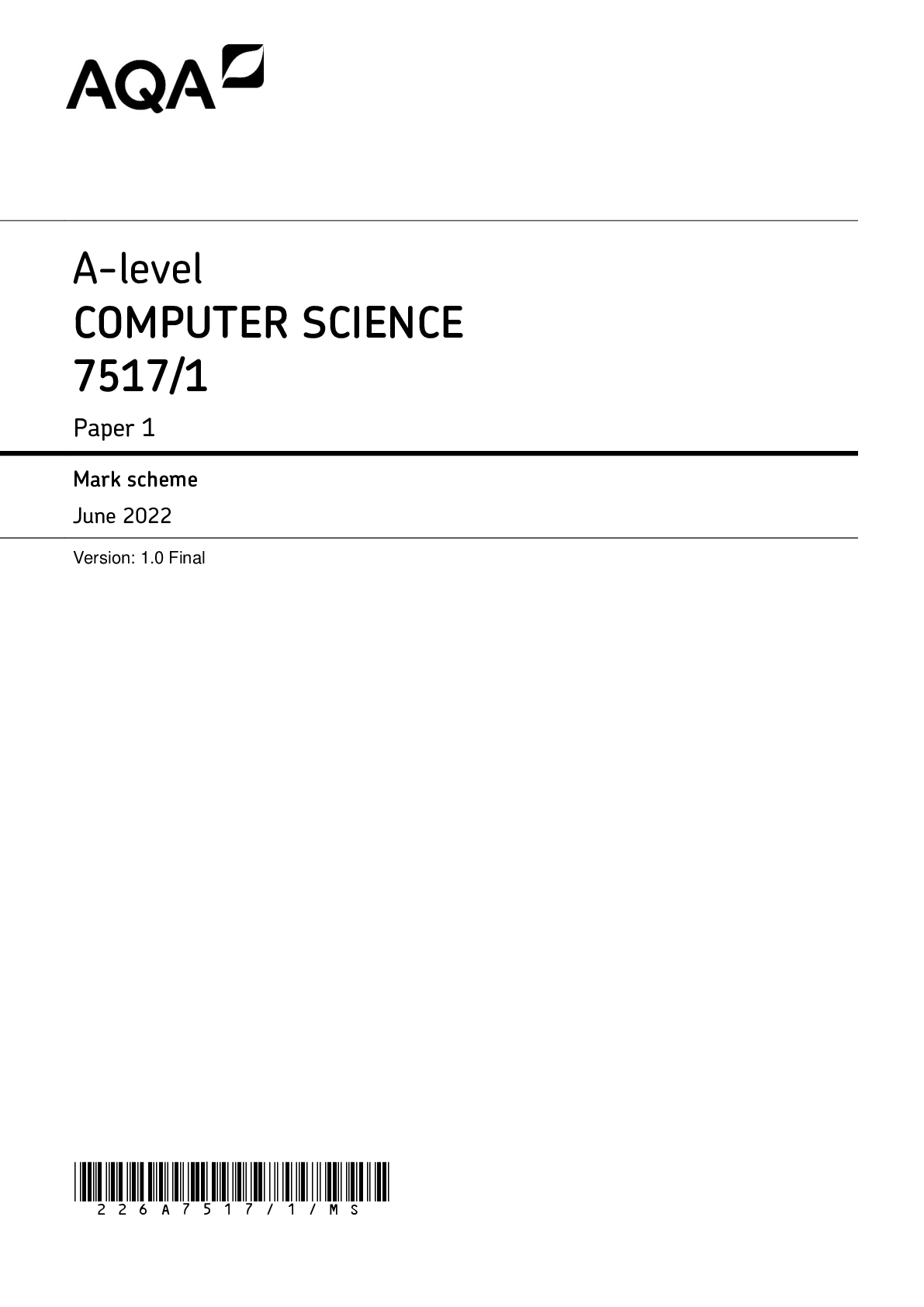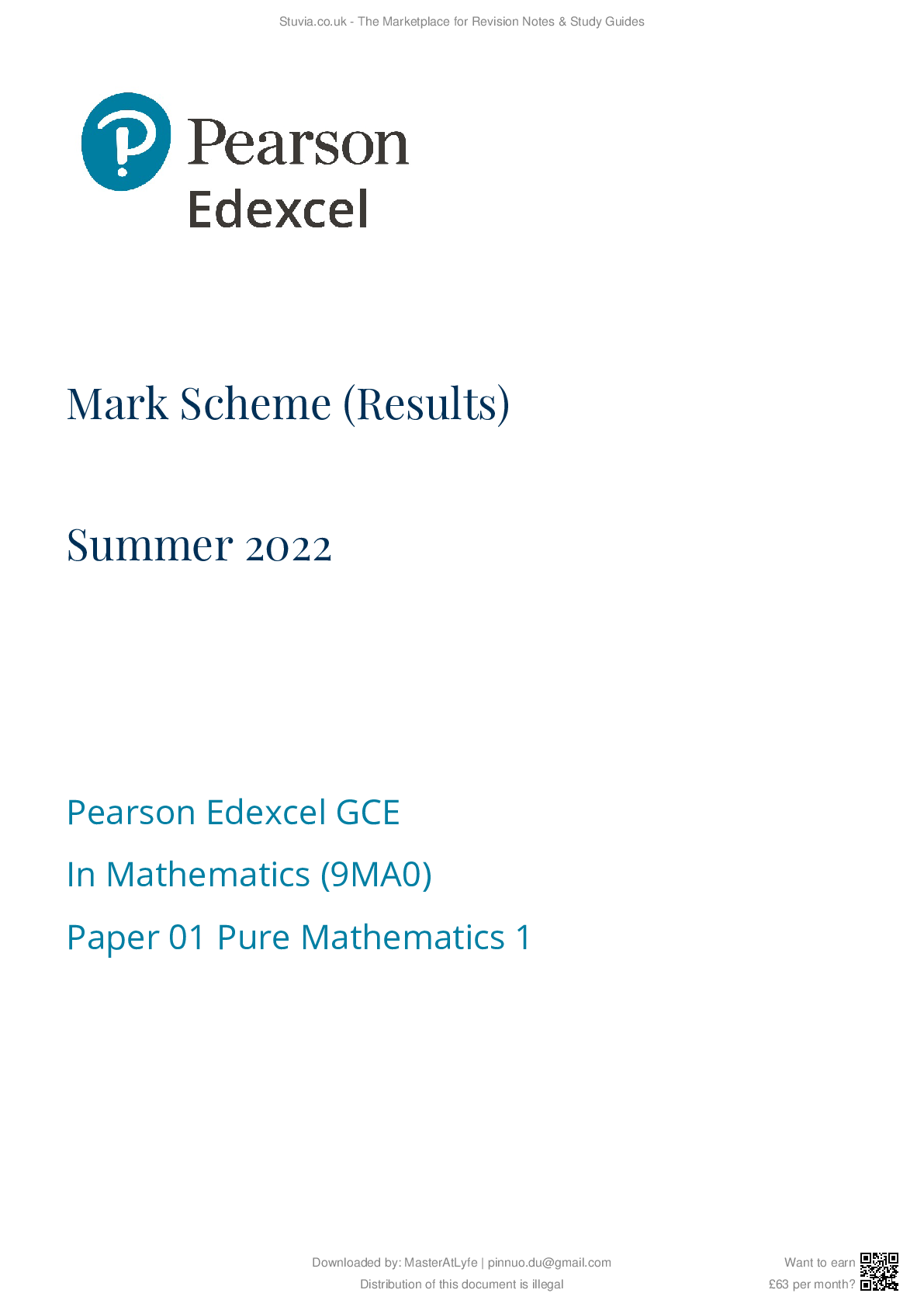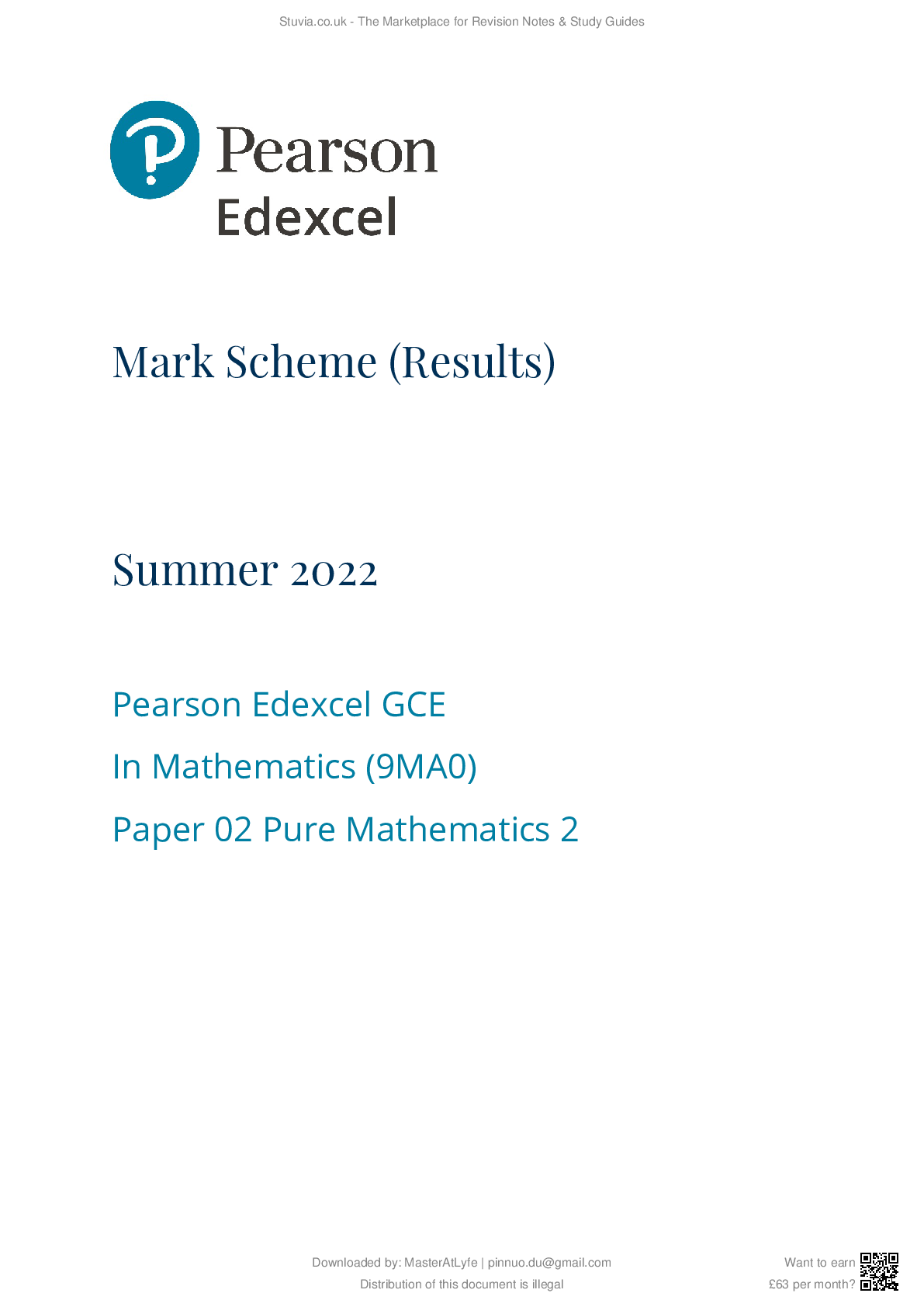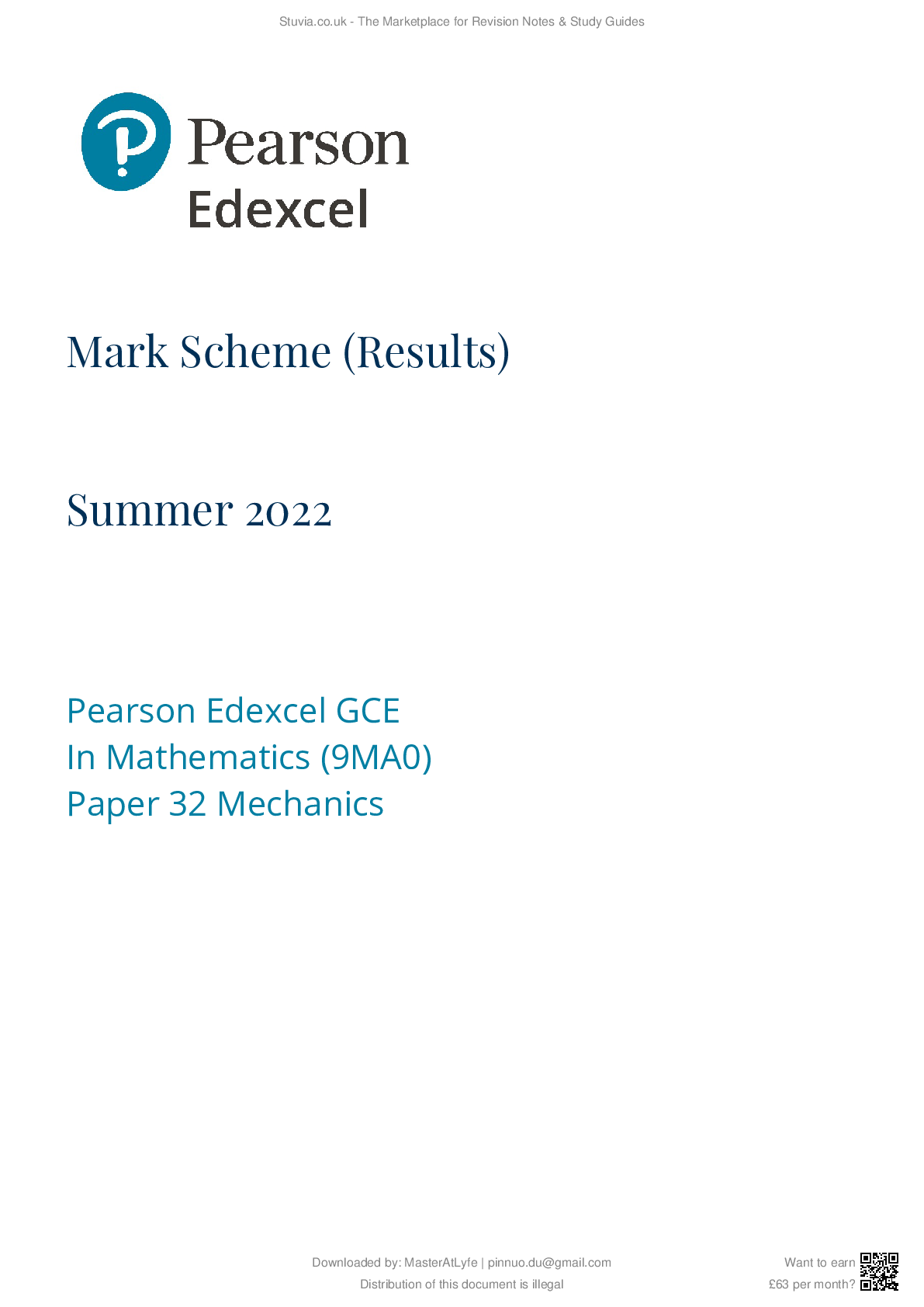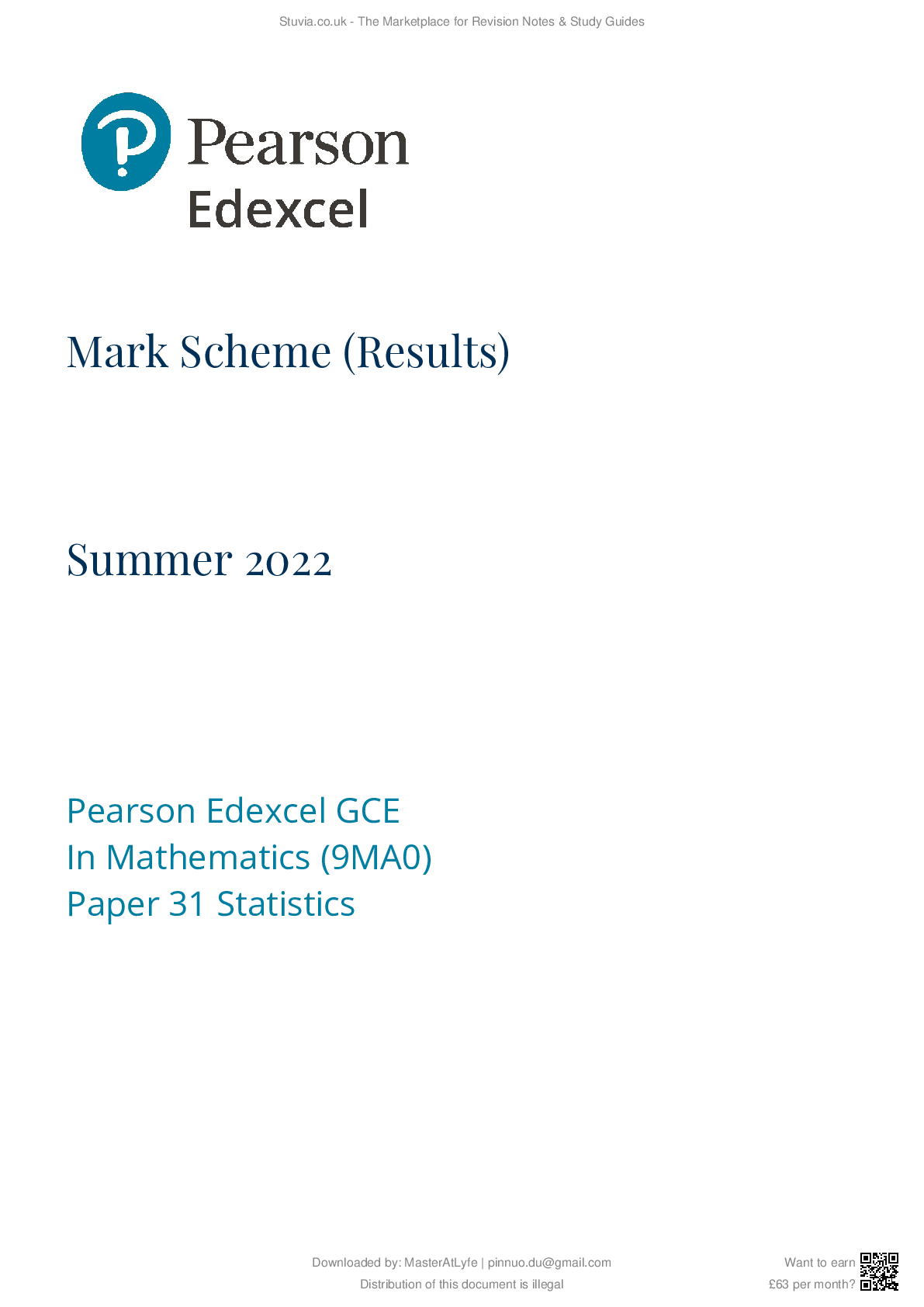Applied Psychology > A-Level Mark Scheme > OCR A LEVEL 2022 PSYCHOLOGY MARK SCHEME -H567-03 PAPER 3-H567/03: Applied psychology (All)
OCR A LEVEL 2022 PSYCHOLOGY MARK SCHEME -H567-03 PAPER 3-H567/03: Applied psychology
Document Content and Description Below
Section A: Issues in mental health Question Answer Marks Guidance 1 (a) Outline one similarity between two historical views of mental illness. AO1 (2 marks) Candidates will display knowledge and... understanding through accurate reference to historical views of mental illness in support of their point of comparison. Examples of creditworthy historical views of mental illness include demonic possession (treated through trepanning), witchcraft, an imbalance in the four humours (including reference to elements, seasons and/or temperature), moral treatment, etc., up to and including the psychodynamic perspective, the anti-psychiatry movement, and even abnormal levels of neurotransmitters. As a rule of thumb, anything that originated in the 1960s or earlier can be treated as historical. AO3 (1 mark) The similarity could be based around debates (e.g. psychology as a science; reductionism/holism; freewill/determinism; ethical considerations); however, other points of comparison are also creditworthy (e.g. the approach to psychology that the historical views reflect; having similar causes; leading to similar treatments). Historical views of mental illness can relate to explanations and/or treatments. The similarity should be clearly identified, and linked to two historical views of mental illness. 3 3 marks – Good comparison. Similarity between historical views of mental illness is identified (1), and supported by relevant evidence from two historical views of mental illness (1+1). 2 marks – Reasonable comparison. Similarity between historical views of mental illness is identified (1), and supported by relevant evidence from one historical view of mental illness (1). 1 mark – Limited comparison. Similarity between historical views of mental illness is identified (1), but not supported by any relevant evidence from historical views of mental illness, or evidence of a historical view is outlined but no (defensible) similarity to another historical view is advanced. 0 marks – No creditworthy response NB If more than one similarity is outlined, then it is the first that should be credited. H567/03 Mark Scheme June 2022 10 Question Answer Marks Guidance 1 (b) Outline one difference between two historical views of mental illness. AO1 (2 marks) Candidates will display knowledge and understanding through accurate reference to historical views of mental illness in support of their point of comparison. Examples of creditworthy historical views of mental illness include demonic possession (treated through trepanning), witchcraft, an imbalance in the four humours (including reference to elements, seasons and/or temperature), moral treatment, etc., up to and including the psychodynamic perspective, the anti-psychiatry movement, and even abnormal levels of neurotransmitters. As a rule of thumb, anything that originated in the 1960s or earlier can be treated as historical. (NB candidates don’t have to use the same historical examples as those referred to in 1a). AO3 (1 mark) The difference could be based around debates (e.g. psychology as a science; reductionism/holism; freewill/determinism; ethical considerations); however, other points of comparison are also creditworthy (e.g. the approach to psychology that the historical views reflect; having different causes; leading to different treatments). Historical views of mental illness can relate to explanations and/or treatments. The difference should be clearly identified, and linked to two historical views of mental illness. 3 3 marks – Good comparison. Difference between historical views of mental illness is identified (1), and supported by relevant evidence from two historical views of mental illness (1+1). 2 marks – Reasonable comparison. Difference between historical views of mental illness is identified (1), and supported by relevant evidence from one historical view of mental illness (1). 1 mark – Limited comparison. Difference between historical views of mental illness is identified (1), but not supported by any relevant evidence from historical views of mental illness, or evidence of a historical view is outlined but no (defensible) difference from another historical view is advanced. 0 marks – No creditworthy response NB If more than one difference is outlined, then it is the first that should be credited. H567/03 Mark Scheme June 2022 11 Question Answer Marks Guidance 2 (a) Describe the characteristics of an anxiety disorder. AO1 (3 marks) Candidates will demonstrate knowledge and understanding by referring to the characteristics of an anxiety disorder. Any appropriate anxiety disorder can be referred to (e.g. phobias; OCD; specific phobias). When describing characteristics, candidates can refer to symptoms but need to convey the extreme nature of them to bring out the ‘disorder’ part of what they are describing as well as the ‘anxiety’ part of it (e.g. avoidance, irrationality, fear or nervousness beyond that which a person might normally feel, signs of physiological arousal that are extreme and/or linked to anxiety rather than some other cause). Other appropriate responses should be credited. 3 3 marks – response demonstrates good relevant knowledge and understanding of the characteristics of an anxiety disorder. (Naming an anxiety disorder and outlining two characteristics will be enough for 3 marks; alternatively, outlining three characteristics with it being clear what the candidate is referring to would also get 3 marks even if a specific anxiety disorder has not been named.) 2 marks – response demonstrates reasonable relevant knowledge and understanding of the characteristics of an anxiety disorder. (e.g. naming an anxiety disorder and outlining one characteristic, or outlining two characteristics of an identifiable anxiety disorder with it being clear what the candidate is referring to even if a specific anxiety disorder has not been named.) 1 mark – response demonstrates limited relevant knowledge and understanding of the characteristics of an anxiety disorder (just naming – accurately – an anxiety disorder is enough for 1 mark, or outlining an appropriate characteristic). 0 marks – no creditworthy response 2 (b) Discuss the usefulness of knowing the characteristics of disorders. AO2 (2 marks) Candidates will demonstrate the skill of application through their discussion being of the usefulness of knowing the characteristics of disorders. (NB candidates don’t need to be referring to the same disorder described in their answer to question 2a). AO3 (3 mark) Candidates will demonstrate the skill of analysis through 5 5 marks – Response demonstrates good application of psychological knowledge and understanding. There is good evaluation that is mainly relevant to the demand of the question. (e.g. two points about usefulness that are distinct from each other and elaborated, with at least one being linked explicitly to characteristics of disorders) 3-4 marks – Response demonstrates reasonable application of psychological knowledge and understanding. There is reasonable evaluation that is partially relevant to the demand of the question. (e.g. for four marks, a candidate may make two points about usefulness that are distinct from each other H567/03 Mark Scheme June 2022 12 Question Answer Marks Guidance the discussion that they generate of the usefulness of knowing the characteristics of disorders. Points made could centre on how such knowledge could lead to more accurate diagnosis or the administration of appropriate treatment. Candidates might also refer to how individuals could feel reassured by an awareness that their experiences arise from a recognised disorder, or how it could help the individual to cope better with the demands placed on them through work, caring responsibilities, etc. Equally, candidates could explore the debate from the other side, arguing that the usefulness of such knowledge is reduced if it adds to a person’s anxiety levels, leads to inaccurate lay ‘diagnoses’, or leads to people noticing ‘symptoms’ that they might not otherwise notice. Points discussed need to be linked to usefulness (i.e. to practical applications). Other appropriate responses should be credited. and elaborated, but there may not be an explicit link to characteristics of disorders) 1-2 marks – Response demonstrates limited application of psychological knowledge and understanding. There is limited evaluation that may be related to the topic area. (e.g. for two marks, a candidate may make one point about usefulness point which is elaborated) 0 marks – No creditworthy response. 3 How might a cognitive psychologist explain to Alex why the pupils may be experiencing mental health problems? AO1 (2 marks) Candidates should demonstrate knowledge and understanding of how a cognitive psychologist might explain mental illness. For example, the work of Aaron Beck might be referred to, or that of Albert Ellis. AO2 (3 marks) Candidates should apply their knowledge and understanding of how a cognitive psychologist might explain mental illness to the scenario in the question. Reference could be made to how pupils might perceive the demands placed on them, such as by examinations, social 5 5 marks – Response demonstrates good application of psychological knowledge and understanding. There is good relevant knowledge and understanding. 3-4 marks – Response demonstrates reasonable application of psychological knowledge and understanding. There is reasonable relevant knowledge and understanding. 1-2 marks – Response demonstrates limited application of psychological knowledge and understanding. There is limited relevant knowledge and understanding. 0 marks – No creditworthy response. Award marks as follows: H567/03 Mark Scheme June 2022 13 Question Answer Marks Guidance media profiles, parental expectations, etc. (For all 3 application marks, candidates can be expected to make two links between their cognitive explanation and the [school pupil] scenario). Other appropriate responses should be credited. • Up to 2 marks are available for a cognitive explanation • Up to 3 marks are available for the application of this cognitive explanation to the [school pupil] scenario in the question Do not credit application of non-cognitive explanations (e.g. behaviourist explanations) 4 (a) Outline two conclusions that can be drawn from these findings. AO3 (4 marks) Candidates are most likely to refer to the greater likelihood of developing either mental disorder if one parent or (even more so) both parents experienced the disorder, and/or to schizophrenia being more likely to lead to admittance than bipolar disorder. They could also refer to how children have a greater likelihood of not developing either disorder, even if both parents had been diagnosed with it. The seemingly greater heritability of schizophrenia could be referred to, but so too could the possibility of symptoms being learned behaviours; also, schizophrenia potentially being easier to diagnose. Other appropriate responses should be credited. 4 3-4 marks – good attempt at outlining two conclusions that can be drawn from these findings with relevant supporting evidence. 1-2 marks – limited attempt at outlining two conclusions that can be drawn from these findings. Either only one conclusion is drawn with relevant supporting evidence, or two conclusions are drawn but with limited supporting evidence. 0 marks – no creditworthy response NB Conclusions need to be distinct from each other; they also need to involve some sort of inference being made from a finding (e.g. referring to a greater likelihood, rather than simply reporting the actual likelihood). Simply reporting a finding without making an inference about it is not creditworthy. If more than two conclusions are drawn, then it is the first two that should be credited. 4 (b) Outline two suggestions a psychologist might make about how these findings could be used. AO2 (4 marks) Candidates could refer to counselling of couples at 4 3-4 marks – good attempt at outlining two suggestions about how these findings could be used with relevant supporting evidence/elaboration. 1-2 marks – limited attempt at outlining two suggestions H567/03 Mark Scheme June 2022 14 Question Answer Marks Guidance enhanced risk of having children with schizophrenia or bipolar disorder to help them with decision-making. They might also suggest interventions to help with parenting. On a wider level, it might be that psychologists would suggest further research to find out why some couples go on to have children with the same disorder as them, but not all do. Suggestions must be ones that psychologists might plausibly make (i.e. they must respect ethical guidelines and show awareness of the socially sensitive nature of these findings). Other appropriate responses should be credited. about how these findings could be used. Either only one suggestion is made about how these findings could be used with relevant supporting evidence/elaboration, or two suggestions are made but with limited supporting evidence/ elaboration. 0 marks – no creditworthy response If more than two suggestions are made, then it is the first two that should be credited. 4 (c) To what extent can these findings be considered reliable? AO2 (2 marks) Candidates should apply their knowledge and understanding of reliability to this quantitative data. Reference to these findings alone is sufficient to potentially access maximum marks. AO3 (6 marks) Candidates should reach a judgement about the extent to which these findings can be considered reliable (and this can be expected of top band responses). Candidates could make reference to the consistent pattern that emerges for both schizophrenia and bipolar disorder in relation to the likelihood of admittance for either disorder increasing if one or (even more so) both parents were themselves admitted with the disorder. The fact that two disorders were studied (rather than one) could also be referred to (although candidates could also look at it from the angle of two disorders rather than more than this). 8 7-8 marks – The response demonstrates good application of knowledge and understanding of reliability. There is a good assessment of the extent to which the findings can be considered reliable. There is a well-developed line of reasoning which is clear and logically structured. The information presented is relevant and substantiated. 5-6 marks – The response demonstrates reasonable application of knowledge and understanding of reliability. There is a reasonable assessment of the extent to which the findings can be considered reliable. There is a line of reasoning presented with some structure. The information presented is in the most-part relevant and supported by some evidence. 3–4 marks – The response demonstrates limited application of knowledge and understanding of reliability. There is a limited assessment of the extent to which the findings can be considered reliable. The information has some relevance and is presented with limited structure. The information is supported by limited evidence. 1–2 marks – The response demonstrates basic application of knowledge and understanding of reliability. There is a basic assessment of the extent to which the findings can be H567/03 Mark Scheme June 2022 15 Question Answer Marks Guidance They could also refer to the large number of couples in each condition, pointing out that larger sample sizes are less vulnerable to being distorted by anomalous findings and, therefore, are more capable of revealing a trend in the data. Points made could also centre on the difficulties of replicating a study with over a million couples being studied (although they could also argue that studies based around analysis of information from a database can be seen as replicable), whether diagnostic criteria were applied in a standardised way, whether the same diagnostic criteria were applied in all cases, etc. Points made need to relate to reliability to be creditworthy (e.g. if they are essentially about another issue, such as validity, they are not creditworthy). Other appropriate responses should be credited. considered reliable. The information is basic and communicated in an unstructured way. The information is supported by limited evidence and the relationship to the evidence may not be clear. 0 marks – No creditworthy response [Show More]
Last updated: 8 months ago
Preview 1 out of 35 pages

Also available in bundle (2)

OCR A LEVEL 2022 PSYCHOLOGY-H567[1/2/3]-COMBINED QUESTION PAPERS 1/2/3 MARK SCHEMES 2022
OCR A LEVEL 2022 PSYCHOLOGY-H567[1/2/3]-COMBINED QUESTION PAPERS 1/2/3 MARK SCHEMES 2022 H567/01 Research methods H567/02 Psychological themes through core studies H567/03 Applied psychology AL...
By QUIZ PRO 8 months ago
$54.5
6

OCR A LEVEL 2022 PSYCHOLOGY-H567/03-COMBINED QUESTION PAPER 3 AND MARK SCHEME 2022
OCR A LEVEL 2022 PSYCHOLOGY-H567/03-COMBINED QUESTION PAPER 3 AND MARK SCHEME 2022 H567/03: Applied psychology
By QUIZ PRO 8 months ago
$15.5
2
Reviews( 0 )
Document information
Connected school, study & course
About the document
Uploaded On
Sep 11, 2023
Number of pages
35
Written in
Additional information
This document has been written for:
Uploaded
Sep 11, 2023
Downloads
0
Views
24




